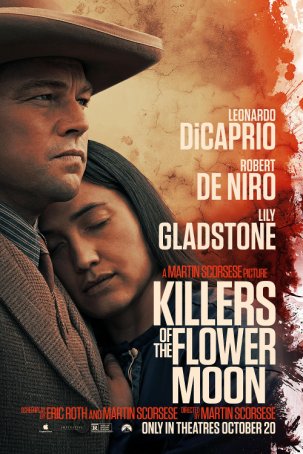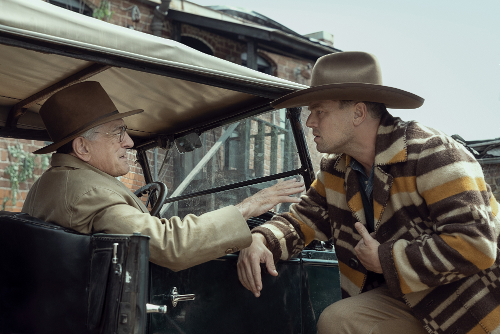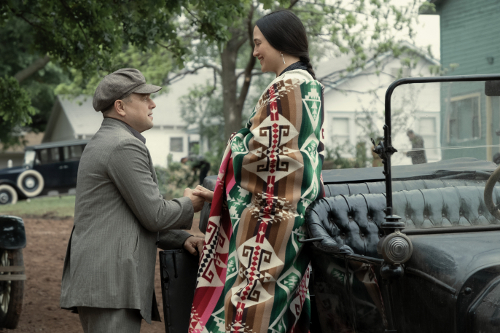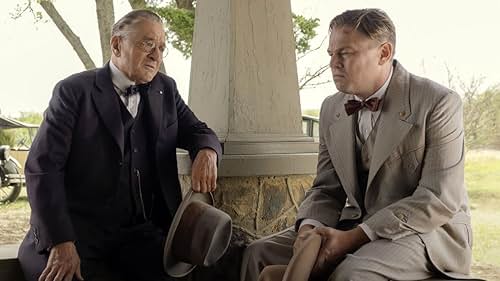Killers of the Flower Moon (United States, 2023)
October 22, 2023
No one can accuse Martin Scorsese of not moving with the times. His latest production, Killers of the Flower Moon, follows in the footsteps of The Irishman in recognizing that the bulk audience will stream the film at home. So, although Scorsese has still made these movies for theatrical release, he has allowed the running time to balloon to around 3.5 hours – a concession to those who prefer to sprawl on a couch while watching a sprawling epic unfold on a screen. (His last film made primarily for cinemas, Silence, was nearly an hour shorter.) The length comes with its share of positives and negatives. With no intermission, it can be difficult for even the most attentive viewer to maintain a high level of concentration for so long. On the other hand, 206 minutes allows Scorsese to tell the story he wants to tell without being artificially constrained. Although the movie suffers from some pacing issues, it is for the most part engrossing and the quality of craftsmanship helps the viewer through some of the slower passages.
This is not great Scorsese. It doesn’t achieve the high level he has reached with his best productions. But it’s nevertheless a very good motion picture (as is true of the director’s “second tier” efforts). Length issues aside, it’s accessible and features strong performances from a stable of recognizable names/faces (and one standout who isn’t as well-known). The film doesn’t lean heavily into the director’s personal vault of tropes, opting instead to focus on character development over narrative thrust. This is as much about the people as it is about the events surrounding them. It’s perhaps unsurprising that I thought about The Treasure of the Sierra Madre while watching Killers of the Flower Moon; both films are about how the pursuit of wealth erodes humanity.
 The story, which adapts David Grann’s investigative book,
spans a six-year period, roughly from 1920 until 1926. As we are informed via
preliminary expository information, huge oil deposits were found beneath the
ground on the Osage Reservation in Oklahoma. As a result of the subsequent royalties,
the Osage became wealthy but the concentration of so much money attracted
opportunists like flies. Some were easily identified and marked. Others,
however, especially those willing to play “the long game,” were able to worm
their way into the people’s confidence and do their damage from within.
The story, which adapts David Grann’s investigative book,
spans a six-year period, roughly from 1920 until 1926. As we are informed via
preliminary expository information, huge oil deposits were found beneath the
ground on the Osage Reservation in Oklahoma. As a result of the subsequent royalties,
the Osage became wealthy but the concentration of so much money attracted
opportunists like flies. Some were easily identified and marked. Others,
however, especially those willing to play “the long game,” were able to worm
their way into the people’s confidence and do their damage from within.
The white man with the greatest influence in Osage County is William “King” Hale (Robert De Niro), a seemingly philanthropic individual whose generous donations have enabled the locals to build hospitals and stores. He is an upstanding citizen, respected by all regardless of skin color. Behind-the-scenes, however, he is the boss of a crime syndicate with wealth and prestige having made him practically unassailable. His nephew, Ernest Burkhart (Leonardo DiCaprio), a WWI veteran, arrives in Osage seeking his uncle’s aid in procuring work. In Ernest, Hale sees an easily-manipulated tool. Soon, the ex-soldier is working on both legitimate and illegal jobs for his uncle. He falls in love with a full-blood Osage woman, Mollie (Lily Gladstone), and the two marry. This kicks into gear one of Hale’s schemes – to gain the headrights of Mollie’s family by eliminating them one-by-one until Ernest inherits. Eventually, however, the body count rises to a point that the Federal Government can no longer ignore it. Bureau of Investigation (the precursor of the FBI) agent Tom White (Jesse Plemons) arrives in Osage with a mandate to investigate, discover, and prosecute. Almost immediately, the focus of his operations is Hale.
 Although Scorsese is best known for certain high-profile titles,
his career has been a study in variety. The bold, energetic violence of his contemporary
crime/gangster films has been matched by such moody, introspective explorations
of the human condition as Silence and Kun-dun. He has never been afraid
to branch out into new fields and, although Killers of the Flower Moon doesn’t
represent a complete break with his most familiar genre (Hale is, after all, a
gangster boss), it feels much different. The behind-the-scenes input of the
Osage Nation in the production helps keep this from becoming a “White Savior”
story – the “Savior” in question, Tom White, has a relatively small role and
doesn’t show up until 2/3 of the way through the proceedings. Although Scorsese
focuses on individual characters, the background of racism and exploitation –
historically undeniable – is baked into the narrative. Scorsese lets it speak
for itself; he doesn’t italicize it or sermonize.
Although Scorsese is best known for certain high-profile titles,
his career has been a study in variety. The bold, energetic violence of his contemporary
crime/gangster films has been matched by such moody, introspective explorations
of the human condition as Silence and Kun-dun. He has never been afraid
to branch out into new fields and, although Killers of the Flower Moon doesn’t
represent a complete break with his most familiar genre (Hale is, after all, a
gangster boss), it feels much different. The behind-the-scenes input of the
Osage Nation in the production helps keep this from becoming a “White Savior”
story – the “Savior” in question, Tom White, has a relatively small role and
doesn’t show up until 2/3 of the way through the proceedings. Although Scorsese
focuses on individual characters, the background of racism and exploitation –
historically undeniable – is baked into the narrative. Scorsese lets it speak
for itself; he doesn’t italicize it or sermonize.
For the first time, the director has brought together the two great actors he has worked with the most – De Niro, who starred in many of the celebrated movies of his early career, and DiCaprio, who succeeded the older man. (The story goes that De Niro recommended DiCaprio to Scorsese after working with him on 1993’s This Boy’s Life.) De Niro plays a familiar type of role – the immoral user whose dark tendencies are hidden behind an urbane demeanor and a disarming smile. Although it’s not new ground for the actor, few do this part as well. DiCaprio has more meat the chew on as the morally confused Ernest, who seems to genuinely love his wife (while participating in her poisoning) and waffles between whether it’s better to stand alongside Hale as the Feds close in or become a law enforcement collaborator. Lily Gladstone’s portrayal of Mollie is measured and understated. The approach works for the most part although one wonders whether a little more emoting might have better “sold” the character’s courtship with Ernest. Supporting performers include Jesse Plemons (taking on the role that was originally offered to DiCaprio), John Lithgow, Brendan Fraser, and the legendary Tantoo Cardinal, who first came to the public’s attention in Dances with Wolves. Scorsese has a cameo late in the proceedings.
 At the ending, Scorsese does something a little different with
the obligatory cataloging of what happened to the various real-life individuals
after the final scene. In this case, instead of the usual series of captions,
he creates a coda mimicking an old-time “true crime” radio broadcast. It’s an
innovative way of providing additional exposition. Maybe someone has done this
before but it’s the first time I have encountered it.
At the ending, Scorsese does something a little different with
the obligatory cataloging of what happened to the various real-life individuals
after the final scene. In this case, instead of the usual series of captions,
he creates a coda mimicking an old-time “true crime” radio broadcast. It’s an
innovative way of providing additional exposition. Maybe someone has done this
before but it’s the first time I have encountered it.
Watching Killers of the Flower Moon requires a degree of patience. Although it is neither boring nor tedious in its progression, neither does it rush forward from big moment to big moment. There are plenty of pauses, tangents, and asides that Scorsese uses to expand the canvas, enrich the characters, and engage in a little world-building. It’s a deeply moving account of a national tragedy that leaves an impact precisely because it doesn’t force-feed its message or function exclusively as a thinly-veiled allegory. This is epic filmmaking and a reminder that the kinds of antisocial, amoral characters who have long represented Scorsese’s bread-and-butter don’t exist exclusively on the mean streets of modern-day America.
Killers of the Flower Moon (United States, 2023)
Cast: Leonardo DiCaprio, Robert De Niro, Lily Gladstone, Jesse Plemons, Tantoo Cardinal, John Lithgow, Brendan Fraser, Cara Jade Myers, Scott Shepherd
Screenplay: Eric Roth and Martin Scorsese, based on the book by David Grann
Cinematography: Rodrigo Prieto
Music: Robbie Robertson
U.S. Distributor: Paramount Pictures
U.S. Release Date: 2023-10-20
MPAA Rating: "R" (Violence)
Genre: Drama/Western
Subtitles: none
Theatrical Aspect Ratio: 2.35:1
- (There are no more better movies of this genre)
- (There are no more better movies of this genre)
- (There are no more better movies of Lily Gladstone)
- (There are no more worst movies of Lily Gladstone)
Comments